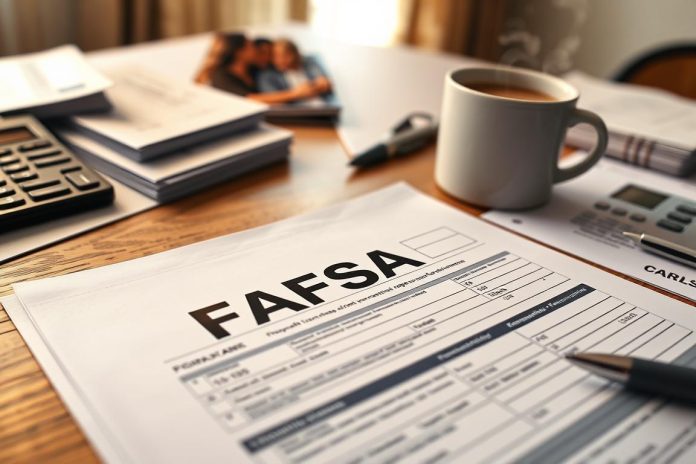In a country where living costs keep climbing, finding the right financial help can seem tough. Yet, hope exists. Programs from the government,
emergency funds, and grants offer some relief. With a little effort, your family could get help from Temporary Assistance for Needy Families (TANF), which gives cash aid for a limited time to qualified families1. Imagine cutting down those high energy bills with the Low Income Home Energy Assistance Program (LIHEAP)1. Also, picture your kids getting the nutrition they need to grow strong from the Special Supplemental Nutrition Program for Women, Infants, and Children (WIC)1.
For parents worried about school costs, the Washington College Grant (WA Grant) shines bright. It offers generous help to families making up to $120,5002. This isn’t just immediate help; it’s investing in your family’s future. Knowing that higher education can mean better earnings than just a high school diploma2, these aid programs act as a stepping stone to financial stability.
As you work towards better economic stability, see these resources as not just quick fixes but as building blocks for a secure future. Using programs like SNAP for daily food or getting help for children with disabilities via SSI1, points to how varied these assistance programs are. Their goal? To make sure no one faces financial hardship alone.
Key Takeaways
- Explore the variety of financial relief programs available to support low- to middle-income families.
- Discover how programs like TANF, LIHEAP, WIC, and SNAP can provide immediate aid for your essential needs1.
- Understand that financial aid, such as the WA Grant, is aimed to support not only immediate needs but also long-term economic stability2.
- Invest in your family’s future by considering the impact of higher education and career training on lifetime earnings2.
- Capitalize on special programs that cater to children with disabilities, supporting their unique challenges through SSI1.
Understanding the FAFSA and Its Impact on Your Financial Relief Programs
Filling out the FAFSA form is a crucial step toward getting financial help for school. It’s not just paperwork; it’s a key to many types of aid that can really help with school costs. Just by applying, you might get access to loans and grants that can make a big difference.
It’s important to apply early for the FAFSA, starting October 1. Aid is given on a first-come, first-served basis. If you wait too long, you might miss out on big financial help. For example, in 2022, many students didn’t get Pell Grants worth $3.6 billion because they didn’t fill out the FAFSA3.
Understanding federal direct loans is key too. These loans are part of the aid you can get after filling out the FAFSA. There are different kinds, like Direct Subsidized Loans for students who need financial help. These loans don’t gather interest while you’re in school at least half-time4.
| Type of Financial Aid | Description | Need-based |
|---|---|---|
| Federal Direct Loans | Includes subsidized and unsubsidized loans provided by the government. | Yes for subsidized |
| Pell Grants | Grants that do not need to be repaid, provided to undergraduate students who display exceptional financial need. | Yes |
| Scholarships | Funds that do not need to be repaid; can be awarded on the basis of merit, need, or a combination of both. | Varies |
Don’t be put off by rumors that your income is too high for aid. There’s no strict income cut-off for FAFSA. Everyone should apply, no matter their financial situation, to not miss any aid they might get4.
The FAFSA is vital for unlocking financial help, but talking to university financial aid advisors is key too. They can offer more personal help and tips on getting the most financial aid possible.
Strategies to Maximize Eligibility for Financial Aid Resources
College costs are going up. Knowing how financial aid works can really help with your planning. It’s important to manage your finances well and use the right savings accounts. These steps can set you up for success.
Asset Management: Smart Saving and Investment Decisions
Start managing assets by saving and investing smartly. A 529 College Savings Plan or a Coverdell Education Savings Account lets you save with tax benefits. These savings are seen as your assets on the Free Application for Federal Student Aid (FAFSA)5. Moving your child’s savings into these accounts early can help a lot with financial aid5. Also, moving assets to these accounts or retirement funds during your child’s sophomore year can protect them from aid calculations5.
How you handle finances is key. By adding more to retirement or looking into solutions that judge assets in a good way, you can get more aid5. It’s about smart planning, not just saving.
Income Adjustment: Legal Avenues to Reduce Taxable Income
Lowering taxable income helps with getting need-based aid. Make sure you report your adjusted gross income accurately on the FAFSA5. Delaying bonuses or taking time off close to the FAFSA period can lessen your income. This may boost your aid chances5. If your income is around $50,000, these steps can help you qualify for more aid. Families using IRS Form 1040A or 1040EZ might get more federal aid5.
Financial Aid for Independent Students: A Closer Look
For independent students, getting financial aid is different. Showing you’re on your own changes how your need is viewed which can increase your aid. Special programs for independent status can offer better grants and loans5.

To wrap up, whether you’re dealing with assets, income, or independent student aid, understanding these principles is crucial. Knowing saving, tax, and income strategies can guide you. Start your journey to more financial aid today!
Conclusion
Understanding debt relief and financial aid is crucial. Acting quickly and being informed is key. Nonprofit hospitals in New Jersey help patients with limited incomes. They offer financial support to reduce healthcare costs6.
Looking into government help and other resources is important. These can help with energy bills, food, schooling, and childcare6.
Knowing your financial options is empowering. In New Jersey, women often need financial help for prenatal care. This shows the role of gender in seeking aid6.
Nonprofit hospitals play a big part in providing financial assistance. Sometimes, this aid is a large part of their income. This underscores their importance in our economy6.
How you handle debt and seek aid matters a lot for your finances. Debt settlement companies might seem like a good idea. But, you need to think about the risks, like lawsuits and hurting your credit score7.
It’s better to look into options like credit counseling or SCRA benefits for servicemembers. These can help you manage debt in a safer way7.
Knowledge is power when it comes to financial freedom. Being strategic about your choices can help you find a more stable and thriving financial future.
FAQ
What types of financial relief programs are available for families in need?
How does filing a FAFSA form help in obtaining financial aid?
What strategies can enhance eligibility for need-based financial aid?
How can income support services and tax strategies help qualify for more financial aid?
What should independent students know about financial aid eligibility?
Are there relief grant programs specifically aimed at educational support?
What is a 529 College Savings Plan, and how does it affect financial aid eligibility?
Can strategies like asset conversion influence financial relief eligibility?
What avenues are available for families to manage energy costs?
How can families with disabled children receive financial assistance?
Source Links
- Financial Assistance for Families | Childcare.gov – https://childcare.gov/consumer-education/financial-assistance-for-families
- Washington College Grant | WSAC – https://wsac.wa.gov/wcg
- What Is FAFSA & How Does It Work? A Guide | Ascent Funding – https://www.ascentfunding.com/blog/fafsa-101/
- Student’s Guide to Financial Aid and the FAFSA | BestColleges – https://www.bestcolleges.com/resources/fafsa/
- Maximizing Your Aid Eligibility – Finaid – https://finaid.org/financial-aid-applications/maximize/
- Understanding Required Financial Assistance in Medical Care | Consumer Financial Protection Bureau – https://www.consumerfinance.gov/data-research/research-reports/understanding-required-financial-assistance-in-medical-care/
- What is a debt relief program and how do I know if I should use one? | Consumer Financial Protection Bureau – https://www.consumerfinance.gov/ask-cfpb/what-is-a-debt-relief-program-and-how-do-i-know-if-i-should-use-one-en-1457/

